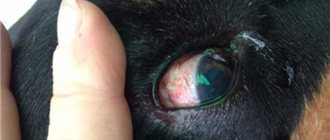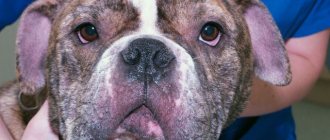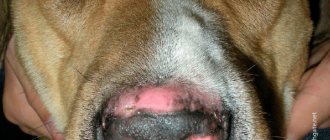This disease is not as scary as it seems. With timely diagnosis, proper treatment and subsequent prevention, the pathology will not bring complications.
Let's consider this and other types of diseases of the visual organ, characteristic of Pekingese, pugs and related breeds.
Help your pet
Don't panic, the less time you need to solve the problem, the better.
Assess the situation - if the missing eye has not completely fallen out, and no more than 15 minutes have passed, then you can help your friend on your own.
If a lot of time has passed, and the eye has slipped out quite strongly and you are in doubt, then apply a napkin soaked in saline solution to the eye, fix it and go to the veterinarian urgently or call a doctor at home.
Find a convenient place in the house where you can restrain your dog. It is very important that the dog is on a non-slip surface; it will be better if someone at home can help you.
Wash your hands thoroughly, or better yet, use an antiseptic. Wipe dry.
Secure the dog with your hand, by the lower jaw - take a clean, cotton scarf or cloth, make sure that there is no foreign material on it - threads or lint.
Moisten with warm water; ideally, a solution of furatsilin or saline solution is also suitable.
Spread your eyelids up and down with two fingers, use a napkin to press on the eye, do everything carefully, but clearly according to the recommendations; when the eye goes inside, you will feel how it has sunk.
Apply a cloth moistened with an antiseptic or sodium chloride solution (saline) - take it to the clinic for examination by a doctor or call him at home.
Often, when there is a big loss of time, when it is no longer possible to do without a specialist, doctors put stitches on the dog’s eyelids so that they come together faster - do not be afraid of this procedure, it will help the pet.
Treatment
Pekingese - description of the breed and character
If you are planning to get a Pekingese, then first read the description of the Pekingese breed; in addition to its advantages, there are also disadvantages.
Most often, after realignment of the eye, temporary sutures are placed on the eyelids. This operation is called “blepharorrhaphy”.
Even after the eye has been set in place, there is a possibility that some kind of infection has entered the body, so the doctor must definitely prescribe you treatment.
It is imperative to wash your eyes and drop drops. The doctor may prescribe you chloramphenicol, tsipromed, tobrex, normax, leopard, gentamicin eye drops.
Prevention and care
- Examine your dog's eyes daily, rinse with a special solution or chamomile decoction.
- See if there is any discharge from the eyes.
- The mucous membranes should always be pink and the conjunctiva white.
- Do not allow large dogs to play with, only small and non-aggressive friends.
- Leave with caution with children.
- Visit your veterinarian for a routine checkup.
- Surgical prevention of loss is a full-fledged operation, but if such cases are frequent with your pet, correction solves the problem.
- When walking on the street, pay attention to what your pet is doing, do not let him climb through trash cans and stir in the dust.
- Avoid fighting with other animals. Don't walk in tall grass, avoid bushes.
- Don't shake the dog.
Photo gallery
Let's look at the healthy and full of strength Pekingese, if you take care of your pet, he will delight you for many years.
Types of eye diseases in small breed dogs
All dog eye diseases can be divided into three types:
- infectious - inflammation that occurs against the background of a general infection with a virus or infection in the visual organ;
- non-infectious (mechanical) – diseases due to eye injury;
- congenital (genetic) occur due to abnormal intrauterine development or against the background of hereditary pathology.
Pekingese have large round eyes.
Such a beautiful unusual shape, unfortunately, becomes the cause of the frequent development of diseases of the organ of vision.
Conjunctivitis
Conjunctivitis is an inflammation of the conjunctiva caused by the entry of an irritant or pathogen from the air onto the mucous membrane. The disease rarely manifests itself as an independent process; more often it is a symptom of an infectious infection of the body.
Important! All breeds with large eyes, long hair and open lower eyelids are at risk, not just Pekingese. In addition to the Pekingese, Yorkshire terriers, poodles, lap dogs, bulldogs, Chihuahuas, and Spitz dogs suffer from chronic conjunctivitis.
Causes of conjunctivitis:
- mechanical (injuries, bruises, burns, frostbite);
- allergic (irritation with allergen);
- fungal and viral infections;
- dermatitis;
- metabolic disease;
- ingrown eyelashes;
- micronutrient deficiency.
There are follicular conjunctivitis (inflammation of the third eyelid with the formation of follicles), catarrhal (mechanical), purulent (due to a viral disease) and allergic.
Each type has different symptoms. General characteristics of conjunctivitis: redness of one or both eyes, mucous yellow or transparent discharge in the corners, increased lacrimation, itching, pain, swelling of the eyelids.
Cataract
The second name of the disease is gray star. It is a complete or partial darkening or clouding of the lens capsule. There are primary and secondary forms of cataracts.
Pekingese and related Asian breeds are characterized by a primary type - hereditary. The disease appears for no apparent reason at 6–7 years of age. It is impossible to prevent the development of the problem, but it is possible to diagnose it in the early stages and stop the process.
The secondary type appears due to abnormal deformations of the eyeball after serious injury, untreated infectious diseases, and diabetes mellitus.
Important! Cataracts are incurable. It is because of this disease that the popular expression “eyesore” appeared.
Corneal erosion
Corneal erosion is another name for “superficial keratitis.” Characterized by damage to the epithelium and inflammation of the cornea. Looks like a green or bluish spot on the cornea. The root cause of the pathology is an untreated inflammatory process in the visual organ (infectious conjunctivitis, for example).
The disease develops gradually: first, swelling appears, blood vessels become noticeable, and the cornea becomes cloudy. With prolonged absence of treatment, peptic ulcer disease and pigmentary keratitis develop.
First, the cause that caused the erosion is treated. Recovery is carried out using antibacterial drops. Less commonly, surgical intervention is required - closing the affected area with the third eyelid.
Other diseases
The dog may also suffer from pathological changes in the upper and lower eyelids:
- blepharitis (unilateral or bilateral inflammation);
- entropion of the eyelid;
- eversion of the century.
Uveitis is often found in pugs, Pekingese and similar breeds - inflammation of the mucous membrane and iris; Ulcerative keratitis is a severe inflammation of the cornea. Glaucoma occurs - a green star associated with increased pressure inside the eye.
A separate problem is retinal detachment. The pathology is hereditary, characterized by lightning-fast progression and requires surgical intervention. Manifests itself as sudden hemorrhage, severe blindness, and absence of the pupil constriction reflex.
Atrophy is an incurable hereditary disease, which, unlike detachment, proceeds slowly. The animal becomes blind with age and the pupil becomes cloudy.
About the disease
With proptosis, the animal experiences a strong forward displacement of the eyeball. It falls out of the bony orbit. The eyelids, which are turned inward due to spasm, prevent the eyelids from setting back, which disrupts the normal anatomical position. With prolonged protrusion of the eye beyond the eyelids, the cornea dries out, becomes damaged, and the blood supply is disrupted.
Expert opinion
Anna Abramenko
An avid dog lover. Experience in veterinary medicine since 2009.
Ask a Question
Doctors make the diagnosis after examining a dog whose eye has fallen out. In order to identify complications, additional measures are carried out - ophthalmoscopy, checking pupillary-motor functions, ultrasound, etc. After assessing the condition of the injured animal, reduction is carried out. The method is chosen by the doctor according to the severity of the injury.
Complications
Loss of an eye can lead to the Pekingese losing sight, developing strabismus, or losing an organ completely, leading to complete blindness.
Treat your pet carefully, visit your doctor promptly, and take care of your dog’s eyes. Remember that this situation may not affect you; there are Pekingese who avoided this. When choosing a puppy, take an interest in the pedigree, examples from the life of the mother or father, and ask about previous litters.
Do not take a dog at the market; understand that healthy and promising pets cannot be bought in such a place.
Causes of eye dislocation
What is the cause of eyeball dislocation?
Photo: the main cause of eye loss in Pekingese is injury
Firstly, the anatomical features of the dog. The Pekingese's eyes themselves are large, and the sockets are not deep enough.
During sudden jumps, fights, or injuries, the eyeball can easily slip out of its socket and terrify the owner and cause a lot of inconvenience for the dog.
Without timely assistance, this is fraught with serious complications.
Secondly, the cause of a dislocated eyeball can be careless handling of the dog. Your slightest careless and incorrect movement or poke in the eye can lead to eye injury and further dislocation.
Therefore, you should not trust the Pekingese to very young children.
Not all Pekingese are predisposed to eyeball loss - this practically never happens in Pekingese with regular eyes (dogs should not have bulging eyes).
It is fair to note that dislocation of the eyeball can occur in absolutely any dog and even in humans.
Care and maintenance of the Pekingese
Proper care of your baby can keep your Pekingese healthy. How to do this, read the article Pekingese: care and maintenance.
Description
These four-legged animals have the following features:
- the height of adult dogs ranges from fifteen to twenty-five centimeters,
- boys weigh about five and a half kilograms, and girls are one hundred grams heavier,
- the fur is long, colors can be different, typical colors are red, black, black and tan,
- Life expectancy with proper care is thirteen to fifteen years, it can be increased through proper care and genetics.
The average price of a show class puppy is from eight hundred to a thousand dollars, but if you need a specimen for home keeping and you do not plan to participate in exhibitions, you can find a baby for fifty to three hundred and fifty dollars.
Training and education
Raising a pet must begin from the first day of its stay in a new home. They immediately explain to the child what is possible and what is not. From an early age, it is necessary to teach your puppy to go to the toilet in a certain place. Pekingese are difficult to train. They are physically weaker than other breeds, so it is necessary to calculate their capabilities. Training should begin with the fu command. The fact is that the dwarf Pekingese loves to chew things, jump, bite, and bark loudly. Therefore, as soon as the owner voices the command, the pet must stop its actions.
You shouldn’t raise your voice at your baby, otherwise he will get scared and won’t listen.
It is necessary to exercise your mini Pekingese at a clearly defined time (for example, after sleep). First they learn simple commands, then more complex ones. The puppy should be praised for its success. Since babies can be stubborn, you need to be persistent and patient.
How to restore the eye to its place?
Prepare a place where the dog will not slip on the surface. Also prepare a napkin - ideally a clean cotton shawl! It is better if you have an assistant, but you can do it yourself. Wash your hands to avoid infection and get to work!
First assess your capabilities - whether you can act quickly, gently, but accurately. Take a look at your eyelids - if they are completely closed behind the eyeball, it will be difficult to cope, then it is better to see a doctor. If the injury occurred 5-10 minutes ago, and the eye is about half out, it is quite possible to cure the pet.
So, if you have already washed your hands, take a cotton swab or pad, or a clean handkerchief. Wet it with cold, but not ice-cold, water.
- Sit your pet down; he's probably acting restless and doesn't want to obey. Grab him firmly by the cheekbones with your left hand.
- Place your index finger and thumb on your eyelids and stretch them in different directions, while with the other hand, place the cotton pad on your eye and carefully, quickly but gently insert it back. You will feel the eye slide back if everything worked out.
- Regardless of the result, apply a warm swab soaked in saline solution - sodium chloride and see a doctor as soon as possible.
If more time has passed, the conjunctiva may dry out. To prevent this from happening, also moisten the eye with saline solution - not necessarily warm - and contact the clinic. Putting off going to the doctor is dangerous, and being afraid of surgery is also dangerous. This will not affect the dog's health.
Dogs live with one eye and look at the world with one eye. We do not want to say that surgery is a given in such cases and we do not wish the worst for your dog! The doctor himself knows what to do and will see it during the examination. Most likely, after the dog's eye is set, stitches will be placed to close the eyelids together.
This is also not something to be afraid of. When the stitches are removed, the eye will already be in place. Also, to restore the body and get rid of a possible infection, the veterinarian prescribes certain medications, and even antibiotics. Take your pet's health seriously, and a speedy recovery will not be long in coming.
kidsdogs.ru
Pekingese diseases, their symptoms and treatment
Spinal diseases
The relatively long and heavy body of the Pekingese creates a load on the spine and provokes diseases . If the dog does not want to play, behaves too calmly, and once again tries not to move, this indicates problems with the spine.
A common disease is displacement or destruction of intervertebral discs . It is believed that the disease is not associated with spinal injuries, but is hereditary. Still, do not allow your pet to go down the stairs on its own.
The disease is determined by the behavior of the Pekingese. When a dog is picked up, it squeals and tenses its abdominal muscles , trying to prevent movement in the spine. Therefore, the disease is mistaken for abdominal pain.
To ease your pet's suffering, try to limit its movements . Place him in a carrier so he can't move. They take the pet out of there just to relieve themselves.
A visit to a veterinary hospital is inevitable. After the examination, the veterinarian will prescribe treatment. Severe cases require surgery.
Heatstroke
The main decoration of the Pekingese is its long, luxurious coat with a thick undercoat. Because of this feature , they do not tolerate heat well and are often subject to heat stroke .
Rapid, heavy breathing indicates heatstroke. The correct temperature is maintained in the dog's room. This will keep your pet healthy and protect against heat stroke.
Important! Don't leave your pet in a locked car in the heat. Heatstroke can lead to death.
In case of heatstroke, the dog is moved to a cool place, the stomach is wiped with a cloth moistened with cold water.
Make sure the bowl always contains fresh water. Anyone who does not plan to participate in exhibitions can give their Pekingese a haircut .
Anal gland problems
A common cause of constipation in Pekingese is blockage of the anal glands . The glands are located near the anus.
If the dog tries to reach its butt with its teeth, moves its butt on the floor, or has difficulty emptying its bowels, then it’s time to clean the anal glands. The procedure is carried out in every veterinary hospital.
What to do if you have seizures
Cramps are involuntary muscle contractions and are accompanied by painful sensations.
Causes:
- a sharp decrease in blood sugar levels;
- liver damage;
- damage to the nervous system;
- cerebral circulatory disorders;
- lack of calcium;
- intoxication of the body.
During convulsions, remove objects that could injure the dog .
Cramps vary in duration, rate of contraction, and number of repetitions . Try to observe how long they last in your dog and which muscles tense:
- several seconds pass, all muscles contract, the pace of contractions is jerky;
- lasts several minutes, muscles contract slowly;
- repeated several times over a short period of time, contractions are frequent.
Notice if the dog loses consciousness . The recorded information will help the veterinarian determine the cause, establish the disease, and begin treatment.
Important! If seizures last more than 10 minutes or occur more than twice a day, contact your veterinarian immediately.
How to treat urethritis in Pekingese
Urethritis is a disease of the genitourinary organs, in which the urethra becomes inflamed, swelling of the mucous membrane occurs, which complicates the excretion of urine. The dog tries to go to the toilet and cannot. With urethritis, the temperature rises, thirst appears, and appetite disappears. Males are more often affected by this disease.
Causes:
- castration;
- infection;
- hypothermia (when lying on cold ground);
- urolithiasis disease.
The medications and treatment regimen for urethritis are determined at the veterinary hospital. If it is infectious, antibiotics are prescribed. If the cause is urolithiasis, then surgery to remove the stones is required. If there is a blockage in the urethra, your veterinarian will drain the urine through a catheter.
Tick bite
Ticks carry deadly diseases. The liver, spleen, kidneys, heart, and nervous system are affected. Because of the Pekingese's thick coat, it is difficult to detect these insects.
When a tick bites, the dog becomes lethargic within three hours, refuses food, and becomes nauseous . The pet's gait becomes uncertain, weakness of the hind limbs is observed, the temperature rises, the urine turns dark, and there may be an admixture of blood.
The tick must be found and removed, so examine your dog carefully. Head, ears, neck - these are the “favorite” places. The bite site is moistened with vegetable oil, wait 3-4 minutes, and twist the tick counterclockwise with tweezers.
If you have symptoms of illness, contact a veterinary hospital immediately! There they will prescribe treatment, give you an injection, and put on an IV.
Remember that determine the cause of your pet’s illness and prescribe treatment.
Dropping out
If a Pekingese's eye falls out, then do not panic, since such a phenomenon is common for this breed. Every owner of such a dog needs to know how to help his four-legged friend and resolve the current situation without consequences.
If a Pekingese's eye falls out, then this is a serious matter. Immediate intervention is needed here. But you shouldn’t try to insert an eye yourself if you don’t have special skills, as you can make it even worse.
Causes and symptoms of eyeball prolapse
The significant reasons for the formation of proptosis are:
- careless grab of the scruff of the neck or hand carrying of the dog;
- sudden jump of an animal;
- insect bites in the periorbital area;
- frequent tugging on the leash while walking;
- squeezing the dog's neck with a collar;
- stressful situation;
- blow to the head and neck on both sides;
- hot weather;
- active movements of the dog when playing with children.
When a dog's eye falls out, signs of proptosis can be determined by the animal's behavior. The dog blinks more frequently, the eye socket protrudes forward and bloody fluid oozes from the eye. If timely medical assistance is not provided, the conjunctiva in the area of the missing eye begins to swell, and the cornea becomes cloudy due to drying of the mucous membrane. The animal becomes apathetic and whines when light appears.
If a dog whose eye has fallen out is not provided with timely medical care, the consequences of proptosis can be:
- loss of functionality of the damaged eye due to rupture or stretching of the optic nerve;
- atrophy and complete blindness due to rupture of the central retina;
- strabismus as a result of rupture of the muscle tissue holding the eye.
Taking care of your Pekingese's health
With good care, staying healthy is easy. The owner must take preventive measures that are aimed at preventing infection with infectious diseases such as rabies, leptospirosis, canine distemper, and hepatitis. Regular, timely vaccination will help avoid these dangerous diseases and keep your Pekingese healthy. Another important procedure is treatment against ticks, fleas and other insects. Despite fairly good health, there are diseases caused by the physiological characteristics of this breed.
Precautionary measures
As we have already said, you need to walk in specially designated places where there are no large canines, and also no plantings whose branches can injure the dog’s eyes. Every walk should be a joy for your dog, because stress can also weaken the muscles that support the eyes.
As you understand, this is a common problem and veterinarians are already accustomed to such a phenomenon as eye realignment in dogs with a short muzzle - Pekingese, pugs.
But you should also know how to straighten your eye if there is no veterinarian on site or if you are in a rural area and there is no way to get to a veterinarian. But first, you should try to prevent such incidents from happening to your furry friend of noble blood.
Don't let children point at the Pekingese's eye, it's dangerous. Therefore, families with small children should not have a Pekingese. Also make sure that the Pekingese does not jump from heights, this can damage the ligaments.
Keep your entire body clean, and examine your eyes especially often. After sleep, every walk, after active play in nature and meeting a big dog. If your eyes are red, be sure to rinse them; the blood vessels under the eyelid should be pink, not bright red. This indicates inflammatory processes. Purulent discharge indicates a bacterial infection, which can also lead to a weakening of the immune system and the muscles themselves.
If it falls out accidentally as a result of an injury, every minute is precious; if you do not insert it back, this is fraught with blindness, swelling of the eye socket and complete tissue death.
But veterinary medicine does not stand still, and for such problems doctors recommend eyelid enlargement (plasty). This is a special operation where incisions are made in the dog so that the dog's eyelids close more. This operation helps prevent many problems. At least reduce their frequency.
Unique breed
The Pekingese can well be called a royal breed, a breed of emperors and court ladies. This unique short-faced dog has an attractive appearance, fluffy “hairstyle” and at the same time an original wayward character. This is not a Chihuahua, but a lion dog, or as it is also called a monkey dog. There is a legend that once upon a time feelings flared up between a lion and a monkey and such a unique baby was born with the character and mane of a lion, but with the face of a monkey.
The legend, of course, is beautiful, but there is some truth in it - a truly noble appearance and character are combined in an original way with a comical monkey face. But the anatomical structure of the Pekingese's flattened muzzle is their advantage and at the same time their misfortune. Imperial dogs have to withstand constant stress on the respiratory system. They often snore during sleep. By the way, they grunt like this while walking because of difficulty breathing. And eyes are a special topic that we want to talk about in detail.
Character
This is a great friend and a wonderful companion, originally he was supposed to entertain the Chinese emperor and was kept as a pet.
Nowadays, this purpose has not changed; people choose these four-legged animals because of their cute appearance and perky character. They are suitable for older people, single people or families with older children. Kids can unintentionally harm the dog, because he is quite small and fragile, and they still do not know how to calculate strength.
These dogs are very loyal to their owner, wary of strangers, and not very friendly to other animals. They may bark loudly or fight with a larger opponent if they feel threatened.
They are characterized by stubbornness, they love attention, and languish without the caress of their owner. They are active and cheerful, love to have fun and play from time to time. Their intelligence is very high, they understand people well, easily get used to new conditions and feel great even in a small apartment.
Representatives of this breed look impressive, have good health, and are quite easy to care for; the only difficulty can be in caring for the coat, which needs to be combed and washed regularly.
Symptoms of the disease
The owner can easily determine that his animal has developed proptosis. This disease is noticeable by a number of symptoms:
- depressed dog,
- increased anxiety;
- frequent blinking;
- drying of the cornea;
- fear of light;
- swelling of the conjunctiva;
- bleeding from the organs of vision;
- protrusion of the body of the eye from the orbit by more than 75 percent.
If such signs are detected, the owner should contact a veterinarian.











